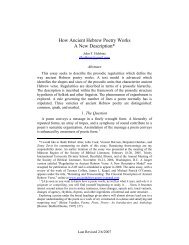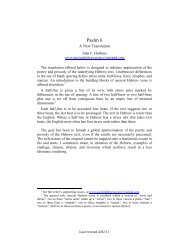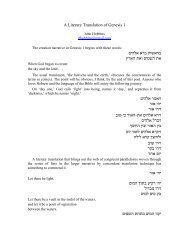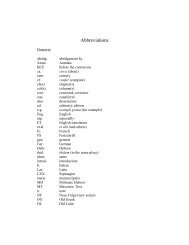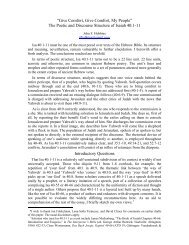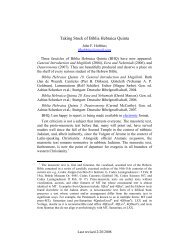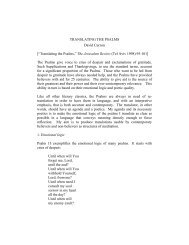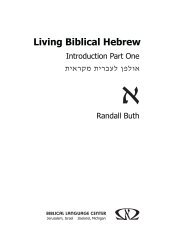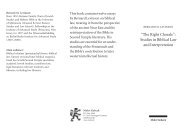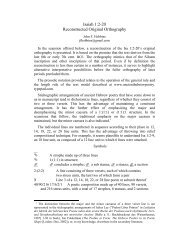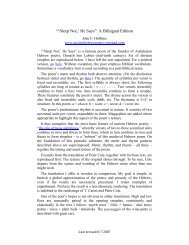Here - Ancient Hebrew Poetry - Typepad
Here - Ancient Hebrew Poetry - Typepad
Here - Ancient Hebrew Poetry - Typepad
- No tags were found...
Create successful ePaper yourself
Turn your PDF publications into a flip-book with our unique Google optimized e-Paper software.
16The levels of the prosodic hierarchy as defined in the general rule requirefurther elucidation. I inscribe my discussion within the theoretical frameworkof the prosodic structure hypothesis formulated by Elisabeth Selkirk andother linguists. 36Translated into the terms of this hypothesis, a stress unit is equivalent to a“prosodic word,” a verset to a “phonological phrase,” a line to an“intonational phrase,” and a strophe to an “utterance.” These equivalencesare discussed below.The fundamental building block of ancient <strong>Hebrew</strong> verse is the prosodicword. There are also prosodic levels below the word which impact ancient<strong>Hebrew</strong> poetry’s rhythms and regularities. They are discussed further on.The Prosodic WordA prosodic word is a unit dominated by a single main stress whosedimensions are equivalent to an orthographic word to which free-standingprepositions and a few other short words may be cliticized. The concept ofthe prosodic word has proven to be of immense utility in the study oflanguages and verse around the world. Its existence is well-attested inTiberian Biblical <strong>Hebrew</strong> (TBH). The phonological and syntacticcombinations that play a role in the rules that determine the boundaries ofsee the writer’s “The Poetic Line in <strong>Ancient</strong> <strong>Hebrew</strong>: A Grid Analysis” at www.ancienthebrewpoetry.typepad.com.36 The study of the prosodic structure of verse is a preoccupation of linguists. See FormalApproaches to <strong>Poetry</strong>: Recent Developments in Metrics (ed. B. Elan Dresher and NilaFriedberg; Phonology and Phonetics 11; Berlin: Mouton de Gruyter, 2006); further, BruceHayes and Margaret MacEachern, “Are there Lines in Folk <strong>Poetry</strong>?” UCLA Working Papersin Phonology 1 (1996) 125-42; Bruce Hayes and Abigail Kaun, “The Role of PhonologicalPhrasing in Sung and Chanted Verse,” The Linguistic Review 13 (1996) 243-303; BruceHayes and Margaret MacEachern, “Quatrain Form in English Folk Verse,” Language 74(1998) 473-507; appendices online at www.humnet.ucla.edu/humnet/linguistics/people/hayes/metrics.htm. For Selkirk’s contributions, see my “Annotated Bibliography,” atwww.ancienthebrewpoetry.typepad.com. The standard introduction to prosodic structuretheory is Marina Nespor and Irene Vogel, Prosodic Phonology (Studies in GenerativeGrammar 28; Dordrecht: Foris, 1986). Briefer treatments include Bruce Hayes, “TheProsodic Hierarchy in Meter,” in Rhythm and Meter (ed. Paul Kiparsky and GilbertYoumans; Phonetics and Phonology 1; San Diego: Academic Press, 1989) 201-260; CarlosGussenhoven and Haike Jacobs, Understanding Phonology (2d ed.; UnderstandingLanguage Series; London: Hodder Arnold, 2005) 217-32. I argue elsewhere that ancient<strong>Hebrew</strong> verse instantiates a prosodic system in conformity with Selkirk’s Strict LayerHypothesis. See “In Search of Prosodic Domains in <strong>Ancient</strong> <strong>Hebrew</strong> Verse: Lamentations 1-5 and the Prosodic Structure Hypothesis,” www.ancienthebrewpoetry.typepad.com.



